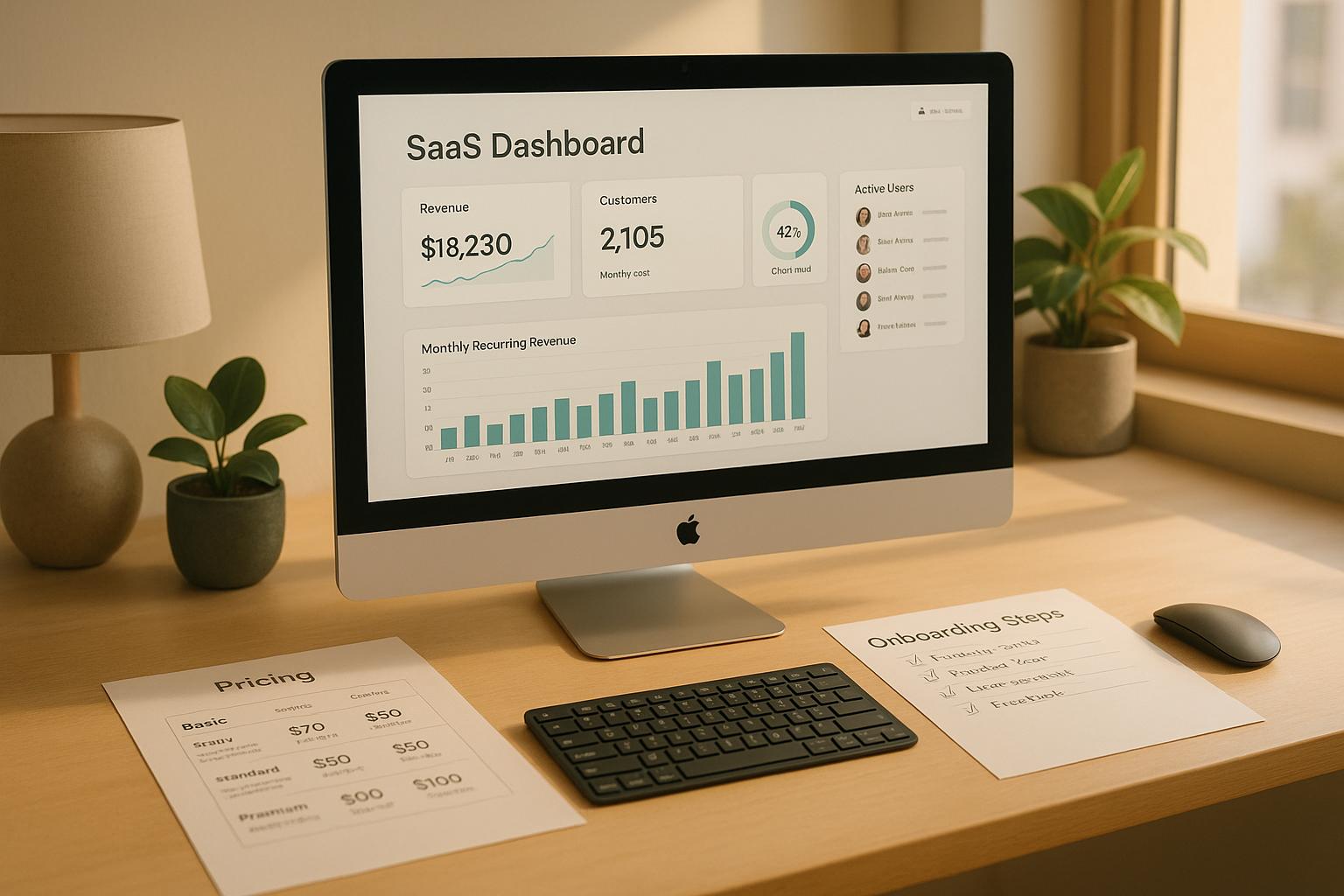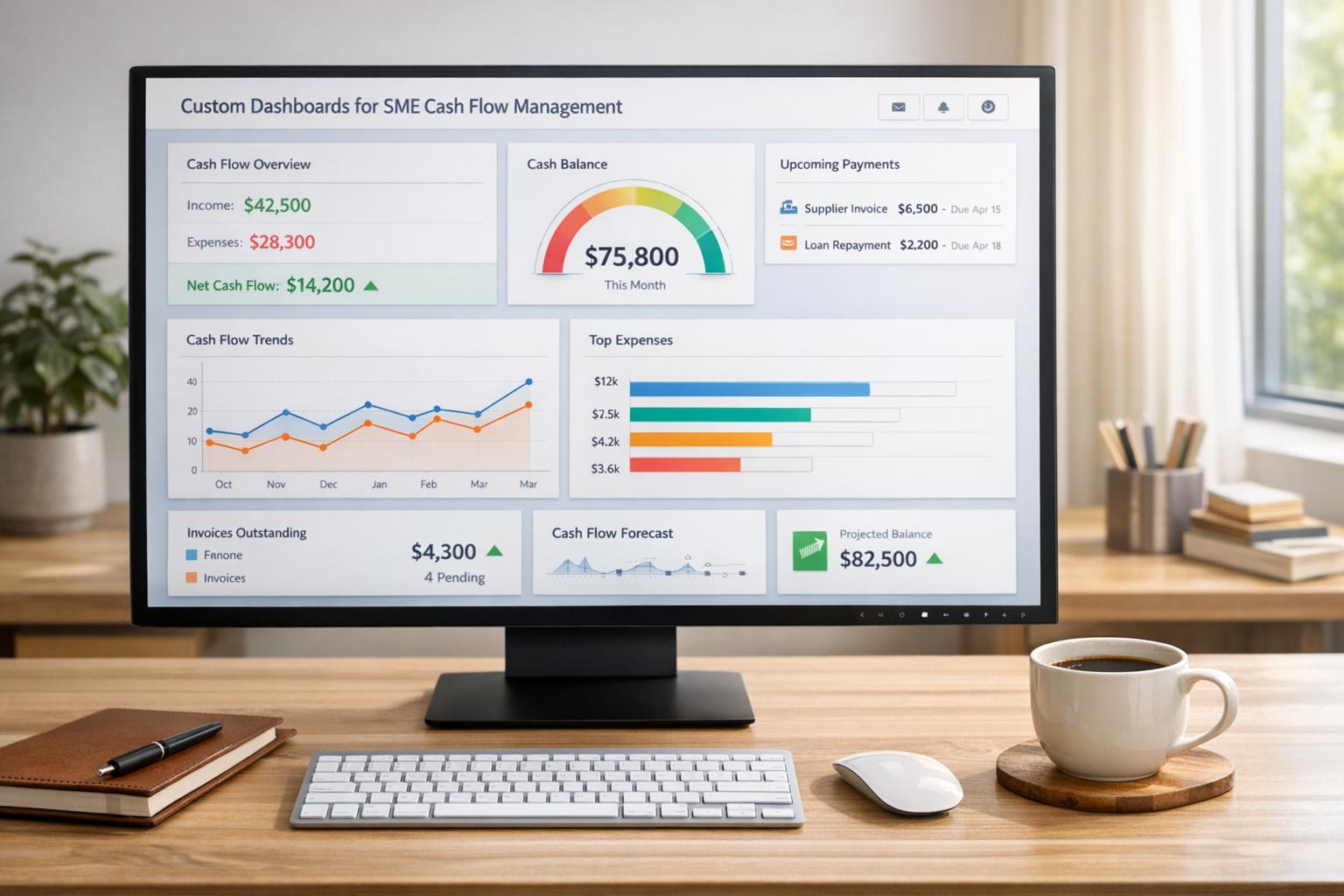Aligning Pricing and Onboarding for SaaS Growth

In SaaS, pricing and onboarding must work together to deliver value and drive growth. Pricing sets expectations for what customers pay for, while onboarding ensures they experience that value quickly. When aligned, this synergy boosts retention, reduces churn, and increases revenue. Misalignment, however, leads to churn, low feature adoption, and rising support costs.
Key takeaways:
- Aligned pricing and onboarding: Smooth transitions, clearer value, and natural upgrade opportunities.
- Misalignment issues: Increased churn, confusion, and missed revenue.
- Solutions: Tailored onboarding by pricing tier, clear feature access, and time-based upgrade incentives.
This strategy isn’t static - it requires ongoing adjustments based on customer behavior and data insights to maintain alignment and maximize customer lifetime value.
Common Misalignments Between Pricing and Onboarding
When pricing and onboarding don’t align, SaaS companies often stumble into predictable pitfalls that disrupt the customer experience. These disconnects can make it harder for customers to see the value they’re paying for, ultimately affecting retention and revenue. Let’s break down three common misalignments and how they impact value delivery.
Onboarding That Doesn’t Reflect Pricing Value
A one-size-fits-all onboarding approach is a common mistake. When every customer gets the same experience, regardless of their pricing tier, it creates a mismatch between their expectations and what they actually receive.
For example, imagine a customer paying $99/month for a professional plan. They expect access to advanced features and personalized guidance, but instead, they’re funneled through the same onboarding process as a $19/month user. This not only diminishes their experience but also undermines the perceived value of higher-tier plans.
Another issue? Premium features that are hard to find. Customers often miss out on the tools they’re paying for because the onboarding process fails to showcase them. A user who upgraded for advanced analytics might spend weeks stuck with basic reports, unaware that predictive insights or custom dashboards are just a few clicks away.
Timing also plays a big role. Many companies delay introducing premium features, thinking it’s better to start simple. But customers paying for top-tier plans aren’t looking for a slow ramp-up - they want immediate access to the tools that solve their specific problems. If onboarding doesn’t highlight these features upfront, it risks leaving them frustrated.
Disconnect Between Pricing Models and Onboarding Behavior
Pricing strategies that don’t align with how users naturally engage during onboarding often create confusion and friction. This is especially true for usage-based pricing models, where customers are charged for things like API calls or data storage. Without clear guidance, users can be left guessing how their behavior affects costs, leading to surprise bills or hesitation to fully explore the product.
Another common misstep is pricing that assumes a linear onboarding journey. For instance, a marketing manager might need access to campaign analytics right away, but the pricing model might restrict this feature until basic tracking is set up. This kind of restriction not only slows down the onboarding process but also creates unnecessary frustration.
Upgrade prompts can also feel out of sync. If a customer is nudged to upgrade before they’ve experienced the full value of their current plan, it can come off as pushy. On the flip side, waiting too long to suggest an upgrade - after the customer has already hit limitations - can lead to missed opportunities and dissatisfaction.
Complex pricing structures only make things worse. When customers struggle to understand what they’re paying for or how to unlock additional value, onboarding becomes more about decoding pricing than exploring the product itself.
Feature Access Issues During Onboarding
Feature access during onboarding is another area where pricing misalignments often surface. Customers paying for premium plans frequently find themselves stuck using basic features, simply because advanced tools aren’t introduced or accessible right away. This delay can be particularly problematic for features requiring setup, like integrations or custom workflows, as customers may lose interest before they even get started.
Permission and access hurdles add another layer of complexity. Some companies require admin approval or extra verification for premium features but fail to communicate this during the sales process. For instance, a customer expecting immediate access to advanced security tools might face days of delays, creating a gap between payment and value.
Navigation and discovery issues are also widespread. Premium features might technically be available, but they’re hidden in menus or buried behind unclear workflows. As a result, customers end up using only a fraction of what they’re paying for - not because the features don’t work, but because they’re hard to find.
Timing is critical when introducing features. Some companies overwhelm new users by rolling out advanced tools too early, while others wait too long and miss the window when customers are most engaged. The sweet spot lies in aligning the introduction of features with both the customer’s pricing tier and their readiness to explore more complex functionality.
When customers don’t fully utilize the features included in their plan, they’re less likely to see the value in upgrading to higher tiers. This not only limits upselling opportunities but also puts a cap on customer lifetime value - all because of misaligned onboarding and feature access strategies.
How to Align Pricing and Onboarding for SaaS Growth
To bridge the gap between pricing and onboarding, it's crucial to create seamless connections between what customers pay and what they experience from the start. Instead of treating these as separate processes, successful SaaS businesses integrate them to consistently showcase value at every interaction. Here's how to make this alignment a reality.
Demonstrating Value During Onboarding
Showcasing value right from the beginning is key. For instance, embedding ROI calculators in the onboarding process can help customers immediately see the benefits of upgrading. These tools can highlight time savings or efficiency improvements tied to higher-tier plans, making the value crystal clear.
Interactive case studies tailored to specific use cases and pricing tiers can also work wonders. By focusing on outcomes that match a customer's investment level, these examples make the benefits more relatable and impactful.
Another approach is real-time value tracking during onboarding. Some companies use dashboards that display metrics like time saved or tasks automated within the first week of use. This immediate feedback reinforces the value of the product and encourages long-term engagement.
These strategies set the stage for tier-specific onboarding journeys that align with the customer's pricing plan, ensuring a better experience and stronger retention.
Designing Tier-Specific Onboarding Journeys
A one-size-fits-all onboarding approach often misses the mark. Instead, creating tier-specific journeys ensures each customer gets the right level of support and feature exposure. For example:
- Basic plan users might focus on mastering core features first.
- Enterprise customers could dive into advanced integrations and custom workflows early on.
By tailoring the onboarding experience, companies prevent both overwhelm and underwhelm, helping users get the most out of their plan.
Additionally, analyzing user behavior during onboarding can reveal when customers are ready for an upgrade. For instance, tracking how quickly they approach plan limits - like storage capacity or API calls - can help you time upgrade prompts more effectively.
Personalized upgrade pathways often perform better than generic options. Instead of showing all available plans, a smart system might suggest the next logical step based on a user's early activity. Conditional access to premium features can also be a powerful motivator, letting customers experience added value before committing to an upgrade.
Leveraging Time-Based Pricing Incentives
Time-based incentives can complement personalized onboarding journeys and encourage early upgrades when engagement is at its peak.
For example, offering a limited-time discount on a higher-tier plan shortly after sign-up can create urgency while the product's value is still fresh in the customer's mind. Similarly, early adopter rewards - like extended trials or bonus features - can incentivize quick upgrades and reinforce the benefits of committing early.
To maintain engagement, stagger the introduction of advanced features. Aligning premium feature rollouts with a customer's pricing tier and usage milestones keeps the experience exciting without overwhelming them.
Seasonal promotions tied to business planning cycles can also be effective. Offering discounts on annual plans during budgeting periods aligns with customer needs and can boost both conversions and cash flow.
The best time-based incentives feel like a natural extension of the onboarding process rather than a hard sales push. They reinforce the value customers are already experiencing and provide a timely reason to upgrade. By addressing common frustrations - like delayed access to features or unclear pricing - these strategies help build a strong foundation for long-term customer retention and growth.
Best Practices for SaaS Pricing Models That Drive Retention
When it comes to keeping customers engaged, pricing models play a key role. They need to clearly communicate value while guiding users through their journey, from discovering the product's benefits to upgrading as their needs grow.
Tiered Pricing with Clear Upgrade Paths
A well-structured tiered pricing model should feel logical and intuitive. Each tier should offer a natural progression of value, making it easy for customers to see why upgrading benefits them. For example, if data shows users bumping up against usage limits during trials, upgrade prompts should align with their actual needs, making the transition smooth and worthwhile.
The tiers themselves should cater to distinct needs. A basic plan might focus on individual productivity, while a professional tier introduces collaboration tools, and an enterprise level could include advanced security and compliance features. These differences should reflect real value - customers should feel they're getting significant benefits for the higher cost. Highlighting these benefits right when users approach their plan limits can encourage upgrades at just the right moment.
This approach ensures that pricing isn't just about numbers; it's about connecting users to outcomes that matter to them.
Value-Based Pricing Aligned with Onboarding Needs
Pricing strategies work best when they align with the results customers achieve during their onboarding journey. Instead of focusing solely on features, consider tying costs to measurable outcomes.
For instance, usage-based pricing works well when tied directly to customer success. If your onboarding process shows that your product reduces manual effort, pricing based on automated task volume makes the value crystal clear. Similarly, outcome-based pricing - like charging a marketing automation platform's customers based on the number of qualified leads generated - can create a direct link between cost and business results.
To make this work, you'll need to establish strong baseline metrics during onboarding to track progress and ensure pricing reflects the value delivered. Additionally, segment-specific pricing can cater to different customer needs. A project management tool, for example, might offer team-size pricing for startups, while enterprises get advanced reporting and compliance features.
That said, keep it simple. Overly complex pricing structures during initial evaluations can create friction and undermine customer trust.
Regular Reviews to Maintain Alignment
Just as onboarding evolves to meet customer needs, pricing models should adapt over time. Regular reviews can help identify misalignments before they become issues.
By analyzing user cohorts and combining data with customer feedback, you can spot trends - like users struggling to reach upgrade thresholds - that may signal it's time to tweak pricing tiers. Annual reviews also allow you to respond to market changes or adjust for new features. For instance, you might add new tiers or simplify existing ones as your product evolves.
Testing can also be invaluable. A/B testing different approaches, such as the timing of upgrade prompts or how tier benefits are presented, can reveal what resonates most with users and improve conversion rates.
The goal isn’t to constantly overhaul your pricing but to make small, incremental adjustments that keep things aligned with customer needs. Monitoring metrics like trial-to-paid conversion rates, time-to-upgrade, and feature adoption can help you stay ahead of potential issues, ensuring your pricing continues to support retention as your customers - and your business - grow.
sbb-itb-e766981
Using Expert Financial Advisory for Alignment Success
Achieving alignment between pricing and onboarding at scale isn’t a simple task - it demands deep analysis, smart modeling, and ongoing fine-tuning. Many SaaS companies struggle to connect the dots between onboarding data and pricing performance, which often leads to missed opportunities for boosting retention and driving growth.
This is where financial advisory experts step in. They provide the tools and strategic oversight needed to build systems that integrate these critical elements. Their expertise in data analysis, financial modeling, and performance tracking can fill gaps that internal teams might not be equipped to handle. With this solid analytical foundation, companies can dig into misalignment patterns and uncover ways to improve.
Analyzing Data to Spot Misalignments
Financial advisors excel at finding hidden patterns in pricing and onboarding data. They can pinpoint where customers drop off, what drives upgrades, and how pricing thresholds influence user behavior.
The process often starts with cohort segmentation, where advisors analyze how different customer groups move through onboarding and react to pricing triggers. For instance, they might identify trends like customers consistently disengaging at specific onboarding steps or upgrade offers failing to convert despite high engagement.
Revenue leakage analysis is another critical tool. It calculates losses from incomplete onboarding or poorly priced tiers, shedding light on lower lifetime values and missed opportunities among trial users who show strong interest.
Advisors also use advanced attribution models to connect onboarding activities with pricing decisions and long-term retention. This helps identify key moments during onboarding when pricing should be emphasized and which value demonstrations are most effective at encouraging upgrades.
Building Integrated Financial Models
Creating financial models that link onboarding milestones to pricing strategies requires a mix of SaaS expertise and forecasting know-how. These models help companies predict customer behavior, refine pricing tactics, and estimate revenue based on onboarding performance.
For example, milestone-based revenue forecasting allows businesses to project future earnings by analyzing how onboarding progress influences upgrade likelihood and customer lifetime value. Financial advisors can design models that show how completing specific onboarding tasks impacts revenue, helping companies focus their efforts where it counts.
Dynamic pricing models also benefit from financial expertise. These models can suggest real-time pricing adjustments based on user behavior, engagement levels, and onboarding progress. For instance, they might recommend offering extended trials to highly engaged users who haven’t upgraded yet or granting access to premium features for users who’ve completed advanced onboarding steps.
Phoenix Strategy Group is a standout in this area, offering tailored financial models for growth-stage SaaS companies. By blending traditional financial modeling with advanced data engineering, they create systems that sync real-time onboarding data with pricing decisions. This approach empowers companies to make data-driven pricing changes that align closely with customer behavior.
Integrating onboarding data into financial models also sharpens unit economics. Advisors can calculate the true cost of acquiring and onboarding customers across various segments, then adjust pricing to balance healthy margins with strong conversion rates.
Testing and Monitoring Alignment Methods
To keep strategies effective as products and markets evolve, continuous testing and monitoring are non-negotiable. Financial advisors bring the expertise needed to design meaningful experiments and interpret their outcomes accurately.
They structure tests to isolate the impact of specific changes, like adjusting the timing of upgrade prompts during onboarding or altering how pricing tiers are presented to trial users. Real-time monitoring systems track key metrics such as time-to-first-value, conversion rates at pricing touchpoints, and the relationship between onboarding completion rates and upgrade behavior.
Benchmarking performance against industry standards can also highlight areas for improvement. Metrics like trial-to-paid conversion rates, average upgrade time, and customer lifetime value across onboarding cohorts provide actionable insights.
Finally, feedback loop optimization ensures that pricing and onboarding strategies continuously inform each other. Financial advisors can set up systems to alert teams when changes in pricing affect onboarding metrics - or vice versa - allowing for quick adjustments to maintain alignment.
Conclusion: Key Takeaways for SaaS Pricing and Onboarding Alignment
Getting pricing and onboarding to work together is a cornerstone of sustainable SaaS growth. When these two areas are aligned, businesses often experience better conversion rates, higher customer retention, and stronger revenue performance. But when they’re out of sync, even the most impressive products can struggle. This balance is key to creating a strategy that’s both effective and data-informed.
Leading SaaS companies excel by using onboarding to highlight the value behind their pricing. They guide users through flows that not only showcase premium features but also naturally lead to upgrade discussions. Every interaction in the user journey should remind customers why their investment is worthwhile and what value they’re receiving.
Data is the backbone of this alignment. Without diving into the numbers, companies risk overlooking crucial insights. These insights are what drive smart adjustments and long-term success.
Phoenix Strategy Group specializes in helping SaaS businesses connect these dots. Their financial models provide clarity on customer acquisition costs, link onboarding milestones to revenue projections, and refine pricing strategies based on real user behavior. With this level of insight, companies can make smarter decisions and fine-tune their approach at every stage of the SaaS lifecycle.
The real secret lies in treating pricing and onboarding as interconnected processes, not standalone efforts. This approach involves constant testing, monitoring, and adapting based on data trends. Companies that master this synergy gain a competitive edge that’s tough to beat.
It’s also important to recognize that alignment isn’t a one-and-done effort. As your product grows and your audience evolves, the relationship between pricing and onboarding will shift. Staying ahead means having the right systems and expertise to adapt quickly, ensuring that what customers pay always matches the value they receive. Keep this integrated approach at the heart of your strategy to consistently deliver on your promises.
FAQs
How can SaaS companies align their onboarding processes with different pricing tiers to improve customer satisfaction and retention?
Aligning Onboarding with Pricing Tiers
SaaS companies can create a more effective onboarding experience by tailoring it to match the needs of each pricing tier. For example, premium-tier customers might appreciate perks like one-on-one onboarding sessions or access to priority support. On the other hand, entry-level users could benefit from self-service tools, such as step-by-step tutorials, FAQs, or automated workflows that guide them through the basics.
Another way to improve the onboarding process is by offering flexible paths that let users select their journey based on their goals or level of expertise. This personalized approach shows customers that their needs are recognized and met, regardless of their subscription level. The result? Customers feel supported, stick around longer, and contribute to sustained growth for the business.
How can SaaS businesses use data to align pricing with onboarding for better growth and retention?
To make pricing and onboarding work hand in hand, SaaS businesses should lean on data insights to craft smooth and effective customer experiences. Start by studying user behavior to fine-tune onboarding processes that showcase the value tied to each pricing tier. For instance, during the setup process, emphasize the standout features that match the customer’s selected plan.
It’s also crucial to monitor metrics like engagement rates, churn, and feature adoption. These numbers can reveal where pricing or onboarding might not be hitting the mark. Use this information to tweak pricing structures or streamline onboarding steps to better align with customer needs. By setting up feedback loops and using tools for data visualization, you can quickly detect and fix any disconnects, boosting both customer satisfaction and retention.
Why should SaaS companies regularly evaluate their pricing models, and how can financial advisory services support this process?
Regularly reviewing and adjusting SaaS pricing models is crucial for staying competitive, boosting revenue, and keeping up with changing customer needs. As markets shift and preferences evolve, fine-tuning your pricing ensures your business stays in step with demand and achieves its growth objectives.
Partnering with financial advisory services, such as Phoenix Strategy Group, can make a significant difference in this process. They provide expert guidance, conduct scenario analyses, and use data-driven strategies to help you refine your pricing, mitigate risks, and focus on sustainable growth. This forward-thinking approach enables SaaS companies to succeed in an ever-changing and competitive market.




